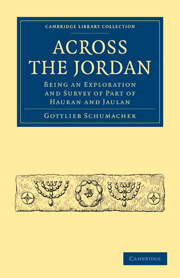Book contents
- Frontmatter
- PREFACE
- Contents
- LIST OF ILLUSTRATIONS
- AN EXPLORATION AND SURVEY OF PART OF JAULAN AND HAURAN
- CHAPTER I GENERAL PHYSICAL CHARACTERISTICS
- CHAPTER II EASTERN JAULAN
- CHAPTER III WESTERN HAURAN
- A TRIP TO THE NORTH-EAST OF LAKE TIBERIAS, IN JAULAN
- A RIDE THROUGH 'AJLÛN AND THE BELKA DURING THE AUTUMN OF 1884
- INDEX
- Plate section
CHAPTER III - WESTERN HAURAN
Published online by Cambridge University Press: 06 December 2010
- Frontmatter
- PREFACE
- Contents
- LIST OF ILLUSTRATIONS
- AN EXPLORATION AND SURVEY OF PART OF JAULAN AND HAURAN
- CHAPTER I GENERAL PHYSICAL CHARACTERISTICS
- CHAPTER II EASTERN JAULAN
- CHAPTER III WESTERN HAURAN
- A TRIP TO THE NORTH-EAST OF LAKE TIBERIAS, IN JAULAN
- A RIDE THROUGH 'AJLÛN AND THE BELKA DURING THE AUTUMN OF 1884
- INDEX
- Plate section
Summary
'Arab el 'Anazeh.—The largest and most numerous Bedawin tribe met with throughout Haurân. The 'Arab el 'Anazeh are divided into four branches: 1. Er Ruwalleh; 2. El Ibsheir (Bisheir); 3. Wulid 'Ali es Smeir; and 4. El Hassaneh. Of these the Wulid 'Ali camp for the most part in Western Haurân and Eastern Jaulân, while the other clans occupy the Jebel 'Ajlûn, a part of the Belkah and the Syrian Desert. Down to the close of the first half of the present century this great Arab tribe held all the country of Jaulân and Haurân, as well as part of 'Ajlûn, and while occupying themselves, for the most part, as highwaymen, were at the same time the ‘protectors’ of certain of the villages against other nomads, for which protection they received the ‘Khuweh,’ or Brother-share, which took the form of a contribution of grain and flocks. A village so taxed was called the ‘Ukht,’ or sister, of the protecting tribe. This method of earning bread without labour was practised down to a very recent date. The deserted villages now so frequently found in the midst of rich fertile lands owe their present desolation to the villagers not having been able to pay their ‘Khûweh’ regularly, and hence having been given over to plunder. The inhabitants, fearing further ill-treatment, have migrated, and settled together, many villages joining to form a single community (as at Esh Shejarah, Tsîl, Tell esh Shehâb, Nawâ), where with greater effect they could resist attack.
- Type
- Chapter
- Information
- Across the JordanBeing an Exploration and Survey of Part of Hauran and Jaulan, pp. 103 - 242Publisher: Cambridge University PressPrint publication year: 2010First published in: 1886

